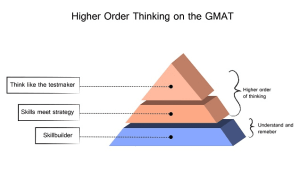Want To Ace Your GMAT Exams? Here Are Some Tips and Tricks For You!

Are your friends tired of you making a business idea out of everything you see? Do you look up to Savitri Jindal, Mukesh Ambani or Gautam Adani for inspiration? If you are someone who wishes to learn the skills needed to run, manage and grow a company, then we are sure you are going to enrol for a business school! You must know about the GMAT too. But where should you start? How can you prove to the top business schools that you are capable of studying there? Can’t make sense of it? Don’t worry we have got you covered! If you didn’t already know, then let us help you- when you want to get into a graduate business program, you must take a GMAT (Graduate Management Admission Test) exam. It is made to evaluate abilities like verbal and numerical thinking that are thought to be crucial for success in a graduate business school. The GMAT is the only part of your application that can objectively compare you to the other candidates. All other application elements, including employment history, extracurricular activities, personal essays, etc, are very subjective.
We know it sounds like a lot and that’s why we have got everything you need to ace this exam! So, let’s dive right in!
But First, Let’s Understand The What’s And Why’s Of GMAT!
Many graduate business schools demand the GMAT (Graduate Management Admission Test) as part of the admissions procedure. The four sections of this computer-based exam are the Verbal, Quantitative, Integrated Reasoning, and Analytical Writing Assessment. The test lasts roughly three and a half hours. The GMAT is assessed on a scale from 200 to 800 with an average score of roughly 550. The majority of students can register for the GMAT online by making an account on the GMAC-run website, mba.com and then book an appointment through the web scheduling system.
Graduate business schools utilise the test scores to select students for admission and to establish a student’s eligibility for scholarships and other types of financial aid. You can receive a 100% scholarship if you have an impressive resume, employment history, and GMAT score of at least 750. Receiving a top GMAT score lets admissions committees know right away that you have what it takes to tackle the demands of an MBA programme. Therefore, it is not uncommon for GMAT scores to be used to determine enrolment in 9 out of 10 new MBA programmes.
There are many top colleges in India that accept GMAT scores as part of their admissions process. Some of the most well-known and highly-ranked institutions include:
- Indian Institute of Management (IIMs)
- Faculty of Management Studies (FMS), University of Delhi
- Indian Institute of Technology, Delhi (IIT) – Bombay, Delhi, Kharagpur, Kanpur, Chennai
- Indian School of Business (ISB)
- XLRI Jamshedpur
- SP Jain Institute of Management & Research (SPJIMR)
Okay, Time For Some Tips And Tricks To Ace GMAT
1. Create a study schedule and stick to it.
MBA and other PG-level business programme applications involve several components, including essays, letters of recommendation, resumes, and more. The last thing you want to do is juggle all of those while also preparing for the GMAT on a cramped schedule. Establish a GMAT study strategy early on in your business school application process to prevent this problem. You can lose a lot of preparation time, energy, money, and peace of mind if you have misconceptions regarding the GMAT. You must ensure that you have a game plan that is focused on learning techniques you can apply on exam day and that provides for a long, realistic runway.
2. Understand the format of the exam and the types of questions that will be asked.
Make sure you are familiar with the format of the GMAT exam before creating a study schedule. Four major sections make up the test:
- Analytical Writing Assessment (AWA part) assesses your capacity for critical thought and idea communication. You will be given a prompt and will have 30 minutes to write your essay. The AWA is scored on a scale of 0 to 6.
- The Integrated Reasoning (IR) component of the test assesses your capacity to evaluate and comprehend information presented in a variety of formats. You will be presented with 12 multiple-choice questions and will have 30 minutes to complete the section. The IR section is scored on a scale of 1 to 8.
- Quantitative Reasoning (Quant section) assesses your capacity for mathematical inference, the resolution of numerical issues, and the interpretation of graphical information. It consists of 37 multiple-choice questions and you will have 75 minutes to complete the section. The Quantitative section is scored on a scale of 0 to 60.
- Verbal Reasoning (Verbal Section) assesses your ability to understand written arguments as well as your reading comprehension and editing skills. It consists of 41 multiple-choice questions and you will have 75 minutes to complete the section. The Verbal section is scored on a scale of 0 to 60.
By switching between two or more sub-sections at once, preparation will only become more time-consuming and ineffective in each of those sub-sections. By overloading your mind with more information than it should or can process at once, you’ll simply increase the likelihood of confusion. Take your time and figure out these sections one by one!
3. Use official GMAT study materials, such as the GMAT Official Guide and GMATPrep software.
You need to know which resources to trust. The Graduate Management Admission Council (GMAC), which manages the GMAT exam, offers the GMAT Official Guide and GMATPrep software as official study resources.
- The GMAT Official Guide is a thorough resource with over 900 practice questions and answers, as well as information on the structure and scoring pattern of the GMAT test. To use the guide effectively, begin by familiarising yourself with the exam’s structure and content by reading through the exam format and scoring information.
- The GMATPrep software simulates a test on a computer, allowing you to practise taking it in a real-world setting. It includes more practice questions as well as two complete practice exams.
In order to practise using the concepts and methods in a true test-taking environment, utilise the GMATPrep software after studying them in the Official Guide. Making use of both these tools together will definitely boost your performance!
4. Practice with mock exams and sample questions to become familiar with the test format and timing.
A full-length mock exam taken in a timed environment is one of the finest ways to get accustomed to the GMAT test format. You will gain a better understanding of the pace and time management techniques you should employ on exam day as a result. It will also assist you in understanding the structure and degree of difficulty of the questions. This involves finding a quiet workspace that is free from interruptions and precisely replicating the test-taking environment. Examine your performance after taking practice examinations and working through sample questions to determine what needs to be improved. This brings us to our next tip!
5. Identify and focus on your weaknesses, and use targeted practice to improve in those areas.
Pay close attention to the questions you had trouble answering, the places where you spent the most time, and the ideas or abilities you found difficult. Make a study plan that focuses on your weaknesses based on how you did on the mock exam. This could be studying with a teacher or a study group, going over certain concepts or abilities again, or doing more practice questions in those areas. For instance, if you have trouble with a particular question type, such as sentence correction or data sufficiency, make a note of it and concentrate on that question type while practising. Ask a tutor or mentor for comments; this can help you identify your strengths and areas for development.
6. Take regular breaks to avoid burnout and use flashcards!
Both taking frequent breaks and employing flashcards are efficient strategies for preventing fatigue and enhancing GMAT performance. It can be tough to study for the GMAT, so it’s crucial to take regular breaks to prevent burnout. In addition to lengthier breaks every several hours, this can also include little breaks every hour or so. Make use of this opportunity to unwind, work out, or do something you enjoy. Flashcards are a helpful study tool for learning and memorization of key vocabulary and ideas. They can be used to examine crucial concepts, formulas, and other data. Make flashcards with significant formulas, definitions, and facts and use them to review and memorise information as well as to review your progress.
7. Some Bonus Tips!
Apart from all this, get enough sleep and exercise to stay physically and mentally sharp.
Please avoid last-minute cramming and try to stay calm during the test. You can always seek additional resources online, such as GMAT discussion boards, and communities which can provide you with more tips and tricks!
Alright Then, Time For You To Shine!
As you embark on your GMAT journey, remember that the road to success is not always easy, but it is always worth it. GMAT is not just a test, it’s a stepping stone to your future. So, take a deep breath, believe in yourself and go for it. And once you conquer the GMAT, don’t forget to come back and share your success story with us!
If you are unsure about your career or need help with cracking exams then we are here for you! Mentoria can help you find clarity. Our four-step career guidance solution is designed to help you find the right career fit from 850+ courses & 12,000+ careers.











